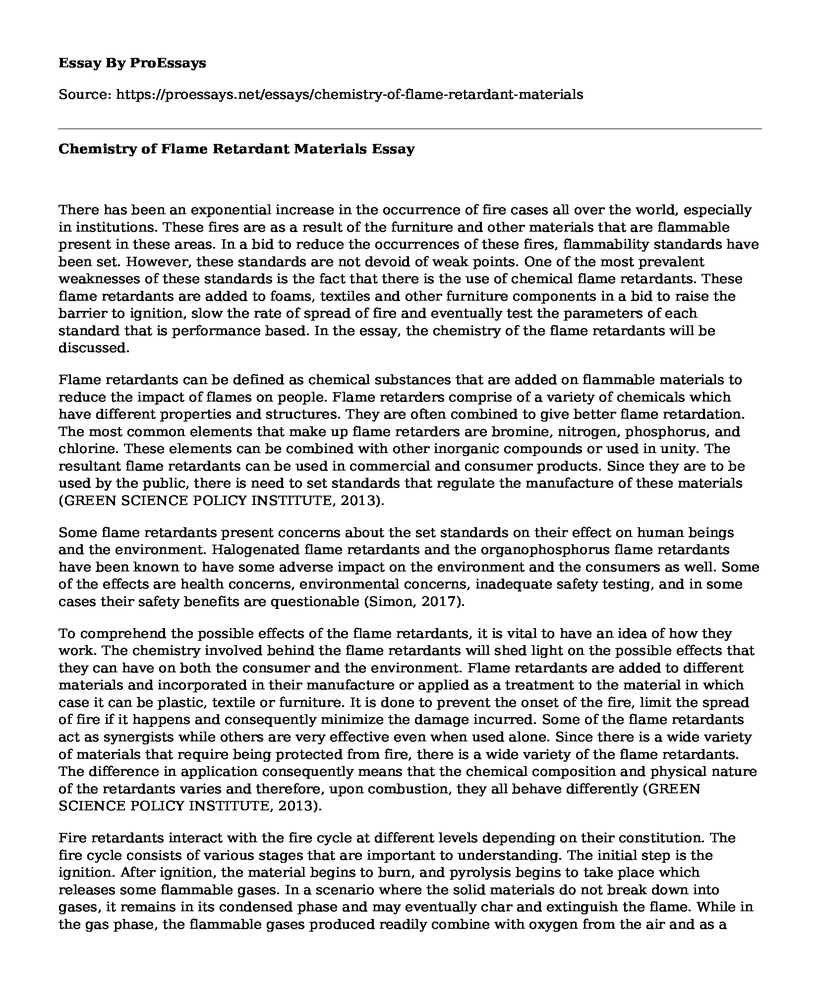There has been an exponential increase in the occurrence of fire cases all over the world, especially in institutions. These fires are as a result of the furniture and other materials that are flammable present in these areas. In a bid to reduce the occurrences of these fires, flammability standards have been set. However, these standards are not devoid of weak points. One of the most prevalent weaknesses of these standards is the fact that there is the use of chemical flame retardants. These flame retardants are added to foams, textiles and other furniture components in a bid to raise the barrier to ignition, slow the rate of spread of fire and eventually test the parameters of each standard that is performance based. In the essay, the chemistry of the flame retardants will be discussed.
Flame retardants can be defined as chemical substances that are added on flammable materials to reduce the impact of flames on people. Flame retarders comprise of a variety of chemicals which have different properties and structures. They are often combined to give better flame retardation. The most common elements that make up flame retarders are bromine, nitrogen, phosphorus, and chlorine. These elements can be combined with other inorganic compounds or used in unity. The resultant flame retardants can be used in commercial and consumer products. Since they are to be used by the public, there is need to set standards that regulate the manufacture of these materials (GREEN SCIENCE POLICY INSTITUTE, 2013).
Some flame retardants present concerns about the set standards on their effect on human beings and the environment. Halogenated flame retardants and the organophosphorus flame retardants have been known to have some adverse impact on the environment and the consumers as well. Some of the effects are health concerns, environmental concerns, inadequate safety testing, and in some cases their safety benefits are questionable (Simon, 2017).
To comprehend the possible effects of the flame retardants, it is vital to have an idea of how they work. The chemistry involved behind the flame retardants will shed light on the possible effects that they can have on both the consumer and the environment. Flame retardants are added to different materials and incorporated in their manufacture or applied as a treatment to the material in which case it can be plastic, textile or furniture. It is done to prevent the onset of the fire, limit the spread of fire if it happens and consequently minimize the damage incurred. Some of the flame retardants act as synergists while others are very effective even when used alone. Since there is a wide variety of materials that require being protected from fire, there is a wide variety of the flame retardants. The difference in application consequently means that the chemical composition and physical nature of the retardants varies and therefore, upon combustion, they all behave differently (GREEN SCIENCE POLICY INSTITUTE, 2013).
Fire retardants interact with the fire cycle at different levels depending on their constitution. The fire cycle consists of various stages that are important to understanding. The initial step is the ignition. After ignition, the material begins to burn, and pyrolysis begins to take place which releases some flammable gases. In a scenario where the solid materials do not break down into gases, it remains in its condensed phase and may eventually char and extinguish the flame. While in the gas phase, the flammable gases produced readily combine with oxygen from the air and as a result, they give rise to a visible flame. The fire becomes self-sustaining since the as the flame continues to burn the material, there is a continuous release of gases that eventually feeds the process even more (GREEN SCIENCE POLICY INSTITUTE, 2013).
With the fire cycle in mind, the flame retardants work in a way that they suppress the cycle. Containing the cycle can be either through disruption of the combustion stage of a fire cycle, limitation of the decomposition process which is done by the physical insulation of the material using a char layer and finally dilution of the flammable gases and oxygen concentrations found in the flame formation zone through emission of water, nitrogen or other unreactive gases.
There are a few properties of concern in some of the flame retardants what have to be addressed. Organohalogen and Organophosphorus retardants have a property of being Persistent Organic Pollutants. As a result, they are likely to cause complications to human health and also affect the environment. The properties of concern they possess are:
- They are persistent which implies that they do not breakdown easily into safer chemicals in the environment.
- They are transported over long distances from the source around the world.
- They are bioaccumulative which means that they constantly build up in human beings and animals and are more concentrated at the top of the food chain.
- They are sometimes toxic to human life. The effects of flame retardants are chronic.
Conclusion
In summation, although there are numerous advantages in the use of fire retardants, understanding of their chemical composition will be an eye-opener to the various advantages and disadvantages of using them. The various effects should be taken into consideration and caution should be taken when choosing the type of flame retardant to use. It is important to remember that prevention is always better than cure.
References
GREEN SCIENCE POLICY INSTITUTE. (2013). Flame Retardants. Retrieved from greensciencepolicy.org: http://greensciencepolicy.org/topics/flame-retardants/
Green Spec. (2018). Halogenated flame retardants. Retrieved from www.greenspec.co.uk: http://www.greenspec.co.uk/building-design/halogenated-flame-retardants-environment-health/
Simon, R. (2017). Flame Retardants. Retrieved from flameretardants.americanchemistry.com: https://flameretardants.americanchemistry.com/Flame-Retardant-Basics/
Cite this page
Chemistry of Flame Retardant Materials. (2022, Mar 29). Retrieved from https://proessays.net/essays/chemistry-of-flame-retardant-materials
If you are the original author of this essay and no longer wish to have it published on the ProEssays website, please click below to request its removal:







